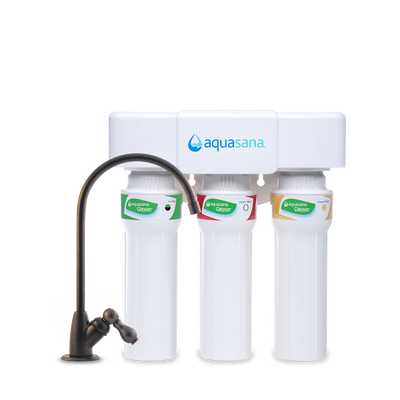Across the United States, somewhere between four and 32 million Americans fall victim to waterborne illness every year. Without a filter installed, contaminants such as lead, chlorine, cryptosporidium, and fluoride make their way into your tap every day.
Across the United States, somewhere between four and 32 million Americans fall victim to waterborne illness every year.
When it comes to the filter in your refrigerator, most come with a filter built in. But how do these filters work, what do they filter out, and can we count on them to get the job done?

How They Work
But let’s follow the path that water takes from the pipe to your glass, starting with your local water treatment plant.
Tap water from local water treatment plants can often contain contaminants like chlorine or chloramine. These chemicals are often used to treat the water itself and remove the contaminants that tend to make people sick. However, even after bacteria have been removed, many studies show that there are still traces of pharmaceuticals, lead and even the germs that can cause sicknesses, including chlorine resistant cysts like giardia and cryptosporidium. Additionally, heavy metals such as mercury and lead in drinking water can be found in certain areas of the country where the infrastructure is deprecated and a little more unkempt.
The Contaminants That Refrigerator Filters Do Sift Out
From the city to your refrigerator, water filters installed within your home can help remove some of those contaminants that we mentioned above (like chlorine taste and odor), but it can’t quite reach everything else. While it’s a hard worker, an overused filter in your refrigerator, especially one that isn’t replaced often enough, lacks the ability to properly remove harmful substances still in the water. Water that passes through old, overused filters can even dislodge some of the trapped pollutants back into your drinking water. On top of that, not all refrigerators have an indicator light to let you know that it’s due for a refill.

Can We Count on them to Get the Job Done?
The biggest problem with refrigerator filters isn’t the actual filter, but the dispenser itself. In 2013, NSF did a study on the germiest places in the kitchen and discovered that most refrigerator water dispensers are coated with ‘concerning levels’ of yeast and mold. This is probably not the most common definition of healthy, clean water.
Rather than using the expensive refrigerator replacement filters made by the original manufacturers of the refrigerator itself, invest in a filter that removes more contaminants prior to entering the fridge. Find the filter that removes contaminants that are most important to you. Keep in mind that if fluoride is at the top of your list, you’ll need a Reverse Osmosis system – which won’t attach to the refrigerator! Make sure to look for a water filter that’s NSF certified to ensure proper contaminant removal. When making a list of household chores, you can also make a mental note to clean the dispenser itself. Clean, healthy water, ice, and dispenser – now that sounds like a healthy, and happy home.
